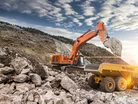Importance of worksite safety ahead of infrastructure boom

Joe Biden's $1.9 trillion coronavirus relief package is expected to raise infrastructure spending significantly in the coming months with construction expected to grow considerably in 2022. Here, Corey Heniser, CEO of Brigade Electronics, explains why worksite safety for the industry has never been more important.
As the US emerges from the COVID-19 pandemic, the construction industry is expected to form an important part of the country's economic recovery, with house building playing a key role. US spending on private construction continued to grow in 2020 with private residential and non-residential buildings seeing some of the biggest ever-recorded figures.
However, statistics show that construction is still one of the most hazardous occupations with 20% of all worker deaths occurring on US construction sites in 2019 – the highest number in any sector. Non-fatal injuries are also a real risk. Accidents often involve heavy machinery and vehicles, which have numerous blind spots that limit operators' visibility, and greatly increase the danger of collision with those working on the ground.
With the number of construction sites increasing, more people than ever will be working with, and around, construction vehicles and mobile machinery. It is vital that every precaution is taken to prioritise the safety of all those on site.
The introduction of commercial vehicle safety systems, such as cameras, alarms, sensors, and vehicle CCTV, have revolutionised the driver and operator experience. These include Brigade's Backeye 360, which provides a real-time 360-degree surround view of a vehicle in a single image. This system provides the driver with instant visibility of the numerous blind spots found on large vehicles, allowing operators to quickly see and react to hazards on the ground. This is especially useful on construction sites where drivers are regularly required to perform low-speed manoeuvres in challenging situations.
Vehicles present a significant risk to construction workers and back over incidents are a real concern. Currently, "beep beep" style reversing alarms are still used widely around the world. However, White Sound reversing alarms provide a much safer alternative. These alarms emit a multi frequency "shh-shh" sound which is more easily detectable by pedestrians and ground workers, allowing them to easily locate where and in what direction a vehicle is reversing, even while wearing hearing protection or working in noisy conditions.
As the country prepares for a building boom, construction companies should ensure that worksite safety remains the top priority for everyone concerned. While technology alone will not solve this issue, it will certainly go a long way towards mitigating hazards and preventing deaths and injuries.
- UK Construction Regulation Changes & What They Mean for YouProject Management
- How Industrial Power Connectors Boost Site SafetyConstruction Projects
- Hitachi: Applying Emerging Tech to Construction MachineryTechnology & AI
- IFS and Anthropic: An AI Alliance For Heavy IndustryTechnology & AI



